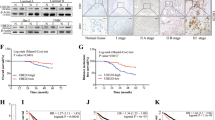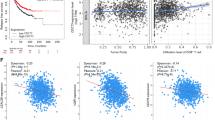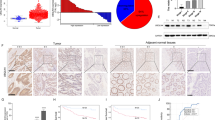Abstract
Ubc9 is an E2-conjugating enzyme that transfers the activated small ubiquitin-like modifier (SUMO) to protein substrates, and thus it has an important function in sumoylation-mediated cellular pathways. We have earlier reported that Ubc9 promotes tumor growth in the xenograft mouse model using breast cancer cell line MCF-7 in part through regulation of Bcl-2 expression. In this study, we show that ectopic expression of wild-type Ubc9 (Ubc9-WT) promotes cell invasion and metastasis. Surprisingly, the dominant negative mutant Ubc9 (Ubc9-DN) also causes the same phenotype, indicating that the ability of Ubc9 to promote invasion and metastasis is distinct from its ability to conjugate SUMO to protein substrates. Of considerable interest, several microRNAs such as miR-224 are regulated by Ubc9. Although ectopic expression of Ubc9 causes downregulation of miR-224, suppression of Ubc9 by Ubc9-siRNAs leads to its upregulation. We further show that miR-224 can inhibit cell invasion and directly targets CDC42 and CXCR4, and that suppression of CDC42 and CXCR4 by RNAi causes inhibition of Ubc9-mediated invasion. Together, these results show a molecular link between Ubc9 and the metastasis genes such as CDC42 and CXCR4, and thus provide new insight into the mechanism by which Ubc9 promotes tumor invasion and metastasis.
This is a preview of subscription content, access via your institution
Access options
Subscribe to this journal
Receive 50 print issues and online access
$259.00 per year
only $5.18 per issue
Buy this article
- Purchase on Springer Link
- Instant access to full article PDF
Prices may be subject to local taxes which are calculated during checkout






Similar content being viewed by others
Abbreviations
- miRNA:
-
microRNA
- PCR:
-
polymerase chain reaction
- RT:
-
reverse transcription
- SUMO:
-
small ubiquitin-like modifier
- UTR:
-
untranslated region
References
Baek SH . (2006). A novel link between SUMO modification and cancer metastasis. Cell Cycle 5: 1492–1495.
Bartel DP . (2004). MicroRNAs: genomics, biogenesis, mechanism, and function. Cell 116: 281–297.
Calin GA, Croce CM . (2006). MicroRNA signatures in human cancers. Nat Rev Cancer 6: 857–866.
Chen C, Ridzon DA, Broomer AJ, Zhou Z, Lee DH, Nguyen JT et al. (2005). Real-time quantification of microRNAs by stem-loop RT-PCR. Nucleic Acids Res 33: e179.
Fazi F, Rosa A, Fatica A, Gelmetti V, De Marchis ML, Nervi C et al. (2005). A minicircuitry comprised of microRNA-223 and transcription factors NFI-A and C/EBPalpha regulates human granulopoiesis. Cell 123: 819–831.
Guo Y, Yang MC, Weissler JC, Yang YS . (2008). Modulation of PLAGL2 transactivation activity by Ubc9 co-activation not SUMOylation. Biochem Biophys Res Commun 374: 570–575.
He L, Thomson JM, Hemann MT, Hernando-Monge E, Mu D, Goodson S et al. (2005). A microRNA polycistron as a potential human oncogene. Nature 435: 828–833.
He X, He L, Hannon GJ . (2007). The guardian's little helper: microRNAs in the p53 tumor suppressor network. Cancer Res 67: 11099–11101.
Johnson ES . (2004). Protein modification by SUMO. Annu Rev Biochem 73: 355–382.
Kaul S, Blackford Jr JA, Cho S, Simons Jr SS . (2002). Ubc9 is a novel modulator of the induction properties of glucocorticoid receptors. J Biol Chem 277: 12541–12549.
Kim JH, Choi HJ, Kim B, Kim MH, Lee JM, Kim IS et al. (2006). Roles of sumoylation of a reptin chromatin-remodelling complex in cancer metastasis. Nat Cell Biol 8: 631–639.
Kobayashi S, Shibata H, Yokota K, Suda N, Murai A, Kurihara I et al. (2004). FHL2, UBC9, and PIAS1 are novel estrogen receptor alpha-interacting proteins. Endocr Res 30: 617–621.
Korpal M, Lee ES, Hu G, Kang Y . (2008). The miR-200 family inhibits epithelial-mesenchymal transition and cancer cell migration by direct targeting of E-cadherin transcriptional repressors ZEB1 and ZEB2. J Biol Chem 283: 14910–14914.
Kurihara I, Shibata H, Kobayashi S, Suda N, Ikeda Y, Yokota K et al. (2005). Ubc9 and protein inhibitor of activated STAT 1 activate chicken ovalbumin upstream promoter-transcription factor I-mediated human CYP11B2 gene transcription. J Biol Chem 280: 6721–6730.
Kurtzman AL, Schechter N . (2001). Ubc9 interacts with a nuclear localization signal and mediates nuclear localization of the paired-like homeobox protein Vsx-1 independent of SUMO-1 modification. Proc Natl Acad Sci USA 98: 5602–5607.
Lao K, Xu NL, Yeung V, Chen C, Livak KJ, Straus NA . (2006). Multiplexing RT-PCR for the detection of multiple miRNA species in small samples. Biochem Biophys Res Commun 343: 85–89.
Liu LB, Omata W, Kojima I, Shibata H . (2007). The SUMO conjugating enzyme Ubc9 is a regulator of GLUT4 turnover and targeting to the insulin-responsive storage compartment in 3T3-L1 adipocytes. Diabetes 56: 1977–1985.
Loffler D, Brocke-Heidrich K, Pfeifer G, Stocsits C, Hackermuller J, Kretzschmar AK et al. (2007). Interleukin-6 dependent survival of multiple myeloma cells involves the Stat3-mediated induction of microRNA-21 through a highly conserved enhancer. Blood 110: 1330–1333.
Lu Z, Wu H, Mo YY . (2006). Regulation of bcl-2 expression by Ubc9. Exp Cell Res 312: 1865–1875.
Ma L, Teruya-Feldstein J, Weinberg RA . (2007). Tumour invasion and metastasis initiated by microRNA-10b in breast cancer. Nature 449: 682–688.
Ma L, Weinberg RA . (2008). Micromanagers of malignancy: role of microRNAs in regulating metastasis. Trends Genet 24: 448–456.
McDoniels-Silvers AL, Nimri CF, Stoner GD, Lubet RA, You M . (2002). Differential gene expression in human lung adenocarcinomas and squamous cell carcinomas. Clin Cancer Res 8: 1127–1138.
Melchior F . (2000). SUMO—nonclassical ubiquitin. Annu Rev Cell Dev Biol 16: 591–626.
Minn AJ, Kang Y, Serganova I, Gupta GP, Giri DD, Doubrovin M et al. (2005). Distinct organ-specific metastatic potential of individual breast cancer cells and primary tumors. J Clin Invest 115: 44–55.
Mo YY, Beck WT . (1999). Association of human DNA topoisomerase IIalpha with mitotic chromosomes in mammalian cells is independent of its catalytic activity. Exp Cell Res 252: 50–62.
Mo YY, Moschos SJ . (2005). Targeting Ubc9 for cancer therapy. Expert Opin Ther Targets 9: 1203–1216.
Mo YY, Yu Y, Theodosiou E, Rachel Ee PL, Beck WT . (2005). A role for Ubc9 in tumorigenesis. Oncogene 24: 2677–2683.
Moschos SJ, Smith AP, Mandic M, Athanassiou C, Watson-Hurst K, Jukic DM et al. (2007). SAGE and antibody array analysis of melanoma-infiltrated lymph nodes: identification of Ubc9 as an important molecule in advanced-stage melanomas. Oncogene 26: 4216–4225.
Nacerddine K, Lehembre F, Bhaumik M, Artus J, Cohen-Tannoudji M, Babinet C et al. (2005). The SUMO pathway is essential for nuclear integrity and chromosome segregation in mice. Dev Cell 9: 769–779.
Park SM, Gaur AB, Lengyel E, Peter ME . (2008). The miR-200 family determines the epithelial phenotype of cancer cells by targeting the E-cadherin repressors ZEB1 and ZEB2. Genes Dev 22: 894–907.
Pillai RS . (2005). MicroRNA function: multiple mechanisms for a tiny RNA?. RNA 11: 1753–1761.
Sachdeva M, Zhu S, Wu F, Wu H, Walia V, Kumar S et al. (2009). p53 represses c-Myc through induction of the tumor suppressor miR-145. Proc Natl Acad Sci USA 106: 3207–3212.
Sentis S, Le Romancer M, Bianchin C, Rostan MC, Corbo L . (2005). SUMOylation of the Estrogen receptor \{alpha\} hinge region by SUMO-E. Mol Endocrinol 19: 2671–2684.
Si ML, Zhu S, Wu H, Lu Z, Wu F, Mo YY . (2007). miR-21-mediated tumor growth. Oncogene 26: 2799–2803.
Singh SK, Kagalwala MN, Parker-Thornburg J, Adams H, Majumder S . (2008). REST maintains self-renewal and pluripotency of embryonic stem cells. Nature 453: 223–227.
Tomoiu A, Gravel A, Tanguay RM, Flamand L . (2006). Functional interaction between human herpesvirus 6 immediate-early 2 protein and ubiquitin-conjugating enzyme 9 in the absence of sumoylation. J Virol 80: 10218–10228.
Viswanathan SR, Daley GQ, Gregory RI . (2008). Selective blockade of microRNA processing by Lin28. Science 320: 97–100.
Wilke K, Gaul R, Klauck SM, Poustka A . (1997). A gene in human chromosome band Xq28 (GABRE) defines a putative new subunit class of the GABAA neurotransmitter receptor. Genomics 45: 1–10.
Wu F, Zhu S, Ding Y, Beck WT, Mo YY . (2009). MicroRNA-mediated regulation of Ubc9 expression in cancer cells. Clin Cancer Res 15: 1550–1557.
Zamore PD, Haley B . (2005). Ribo-gnome: the big world of small RNAs. Science 309: 1519–1524.
Zhu S, Wu H, Wu F, Nie D, Sheng S, Mo YY . (2008). MicroRNA-21 targets tumor suppressor genes in invasion and metastasis. Cell Res 18: 350–359.
Acknowledgements
We are grateful to Dr Joan Massagué for providing LM2-4142 cells. This study is supported by grants CA102630 from NCI and postdoctoral fellowship award from Illinois Department of Public Health.
Author information
Authors and Affiliations
Corresponding author
Additional information
Supplementary Information accompanies the paper on the Oncogene website (http://www.nature.com/onc)
Supplementary information
Rights and permissions
About this article
Cite this article
Zhu, S., Sachdeva, M., Wu, F. et al. Ubc9 promotes breast cell invasion and metastasis in a sumoylation-independent manner. Oncogene 29, 1763–1772 (2010). https://doi.org/10.1038/onc.2009.459
Received:
Revised:
Accepted:
Published:
Issue Date:
DOI: https://doi.org/10.1038/onc.2009.459
Keywords
This article is cited by
-
Construction and validation of a two-gene signature based on SUMOylation regulatory genes in non-small cell lung cancer patients
BMC Cancer (2022)
-
UBE2I promotes metastasis and correlates with poor prognosis in hepatocellular carcinoma
Cancer Cell International (2020)
-
Quantitative SUMO proteomics reveals the modulation of several PML nuclear body associated proteins and an anti-senescence function of UBC9
Scientific Reports (2018)
-
Comprehensive list of SUMO targets in Caenorhabditis elegans and its implication for evolutionary conservation of SUMO signaling
Scientific Reports (2018)
-
Upregulated microRNA-224 promotes ovarian cancer cell proliferation by targeting KLLN
In Vitro Cellular & Developmental Biology - Animal (2017)



